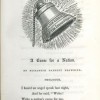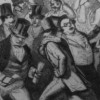
Jason Camlot, “The First Phonogramic Poem: Conceptions of Genre and Media Format, Circa 1888”
By 1888, the technology of the phonograph, and the medium of the phonograph cylinder, were established as market-ready. What was the imagined potential of this media technology in relation to known modes of communication and expression? This article recounts how “The Phonogram” or phonographic letter was prototyped from 1887 to 1892 through the efforts of Thomas Alva Edison and his London agent George Gouraud. Edison’s prototyping work and Gouraud’s efforts in developing recordings, scripts for phonogramic speeches, and formats for typographical transcription of the cylinder recordings represent a rich case study for documenting the nature and significance of their efforts to consolidate the medium and define the generic parameters of the phonogram (a speech recording) as a distinct form of global communication. By theorizing the relationship between late-Victorian concepts of medium, format and genre, respectively, and by interpreting the “first phonogramic poem” (16 June 1888) as an articulation of the meaning of sound recording at the historical moment that it arrived as a viable media technology, this article helps explain how sound recording technologies were imagined in relation to specific genres of communication. Drawing upon periodical literature, and documentation available through the Thomas Edison Papers archive—including phonogramic transcripts and speeches, marketing and foreign business strategies, patent applications, and packaging and design documents—this article explains, in particular, the generic and rhetorical protocols that informed the attempt to establish the phonogram as a new medium of intimate communication and international correspondence.

Denae Dyck and Marjorie Stone, “The ‘Sensation’ of Elizabeth Barrett Browning’s Poems before Congress (1860): Events, Politics, Reception”
Elizabeth Barrett Browning’s Poems before Congress paradoxically addresses a political event that never took place: a meeting of European powers to discuss the “Italian question” planned for January of 1860. Nevertheless, the collection addresses several momentous historical developments, including the Second Italian War of Independence in 1859, the intervention of Napoleon III of France in the Italian struggle, and the international conflict his intervention precipitated. Indeed, the book’s publication and the sensation it created in themselves constitute a plurality of events, since the collection appeared under differing titles in England and America and encountered differing responses in each country. Contrary to the still dominant critical view that the volume was almost universally denounced, its reception was shaped by diverse locations, shifting chronological contexts, and conflicting political affiliations. Close analysis of the reviews underscores the importance of these wider contexts, which influence what otherwise appear to be primarily literary or aesthetic judgements. At the same time, analysis of varying responses to not only “A Curse for a Nation” but also “Napoleon III in Italy” and other poems in the volume demonstrates a number of recurring points of contention. These include the collection’s title, the politics of interventions across national borders, English liberalism, the nature of democracy, cosmopolitanism versus nationalism, women writers in relation to politics, poetic form, and, most of all, EBB’s representation of Napoleon III—the issue that is front and centre in most of the 1860s reviews and that shaped, in turn, reactions to all the rest.

Lynn Shakinovsky, “The 1857 Financial Crisis and the Suspension of the 1844 Bank Act”
The 1857 financial crisis began in the United States and reached England in October of that year with the fall of the Liverpool Boro’ Bank. This essay examines representations of and responses to the crisis by some of the major figures and key sources of the period. While an increasingly widespread acknowledgement of the inevitability, at times even of the desirability, of crisis manifests itself in various representations and discussions of the financial crisis, the diverse ideological assumptions and expectations of various writers, politicians, and journalists proffer widely differing explanations and solutions. These range from Marx and Engels who saw in the crisis the opportunity for revolution, to entrenched capitalists who regarded it as a necessary occurrence for the promotion of further growth, to politicians and bankers who called for new interventions in the Banking system. Through an investigation of political, journalistic, and academic responses to the 1857 crisis and the suspension of the Bank Charter Act of 1844, this paper explores the political and economic significance of the crisis for mid-century global capitalism and the Banking system.

John M. Picker, “Threads across the Ocean: The Transatlantic Telegraph Cable, July 1858, August 1866”
This essay considers the significance of one of the signal technological developments of the nineteenth century—an event so signal that it happened twice. The transatlantic telegraph cable linking the Old World with the New was first successfully completed in August 1858, only to cease functioning within a month, and was permanently re-established in July, 1866, this time accompanied by the reappearance, with slight variations, of much of the verse and prose written to commemorate the original success, in what might be considered a case of canny cultural recycling. While the cable ultimately connected England and the United States, it only did so by way of Ireland and Canada, which is to say that this was very much an imperial project, one celebrated as reinforcing transatlantic ethnic and linguistic superiority in a mythology of Anglo-Saxonism that Victorians largely constructed and widely endorsed. As a way to approach this convergence of ideologies of progress, empire, language, and race, the essay focuses on what arguably was the critical aspect of the cable’s material composition, and considers, in general terms and in the specific literary case of Henry James, how the concept of insulation can help us to interpret representations of the cable and the transatlantic ties it extended.
